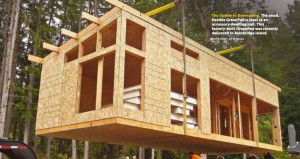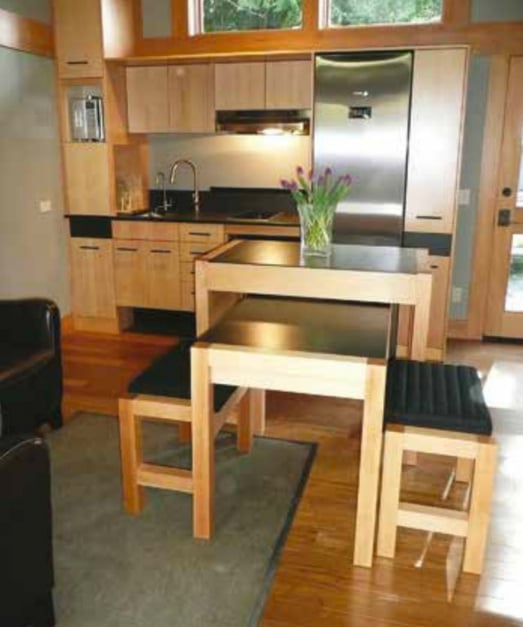Tax Credit Updates Every Industry Pro Should See
Learn what’s changing—and what’s not—with energy tax credits for SIP projects. Get the latest updates on 25D, 45L, 179D, and..
Originally published in GreenBuilder Magazine, pg 34
INSPIRED BY THE NOTION OF STREAMLINING SUSTAINABLE BUILDING, SEATTLE-BASED GREENPOD DEVELOPMENT CREATES ENERGY-EFFICIENT, LOW-MAINTENANCE MODULAR HOMES WITH HEALTHY INTERIORS.
 Green Builder Magazine, Resilient Housing
Green Builder Magazine, Resilient Housing
Seattle-based GreenPod offers factory- and site- built homes that are sustainable to the last detail. The WaterHaus, a 450-square-foot model home built in Port Townsend, Washington, exemplifies what the company is trying to accomplish with its compact, flexible homes. For starters, the floors, walls and roof of the home are made with structural insulated panels (SIPs).
“The homes are pre-cut when they come out of the factory, so they can go up in a day or two on the site,” says Ann Raab, GreenPod’s founder. “Everything about SIPs delivers what we are trying to create.”
Raab says SIPs offer the “best bang for your buck.” Although they are slightly more expensive than a conventional wood frame, SIPs have a short 2.7-year payback; they are stronger and straighter than wood, and pre-cutting them virtually eliminates job waste. Using SIPs also prevents gaps in the insulation and minimizes thermal transmission.
“Because we want the insulation to be continuous, we keep the penetrations to a minimum, which also ensures no mold and mildew,” explains Raab. “GreenPod homes are all about saving energy.”
GeenPod homes embody the beauty of downsizing and living simply and sustainably. They can feature movable walls, solar panel roof decks and natural lighting. High-transom windows provide privacy, and interior glass visually enlarges the living spaces.
 The Upside to Downsizing. The small, flexible GreenPod is ideal as an accessory dwelling unit. This factory-built GreenPod was recently delivered to Bainbridge Island. Photo Credit: Joe Reynolds
The Upside to Downsizing. The small, flexible GreenPod is ideal as an accessory dwelling unit. This factory-built GreenPod was recently delivered to Bainbridge Island. Photo Credit: Joe Reynolds
Most modern homes contain numerous electronic gadgets that drain energy and create electromagnetic fields that can impact health. GreenPod homes contain “kill switches” that cut power to specific outlets, thus reducing plug loads and creating healthy neutral zones. Clay wall finishes, all-organic textiles, a biofilter refrigerator and the absence of combustible products promote superior indoor air quality.
GreenPod Development offered interior furnishing packages, including furniture, maximizing the utility of these small homes and helping people to downsize – while maintaining a high standard of living. The company currently serves Washington State and California, but Raab says they are focusing on exporting concepts, rather than the actual GreenPods, so that other communities can develop networks to support sustainable, healthy homes.
GreenPod Modular Homes at a Glance
 Finishing Details. The WaterHaus contains a collection of Art We Live In – local and sustainable products such as stacking tables, doors, lighting, ladders, beds and linens, to maximize the possibilities of this 450-square-foot space.
Finishing Details. The WaterHaus contains a collection of Art We Live In – local and sustainable products such as stacking tables, doors, lighting, ladders, beds and linens, to maximize the possibilities of this 450-square-foot space.
Pros:
Cons:
Learn what’s changing—and what’s not—with energy tax credits for SIP projects. Get the latest updates on 25D, 45L, 179D, and..
SIP Myths: These are the most common misconceptions our sales reps hear in the field, and we’re here to set the record..
Premier SIPS earns top industry awards for innovation, sustainability, and high-performance construction, showcasing SIPs'..
As the oldest SIP manufacturer, Premier SIPS offers a superior building envelope framing system for commercial and residential structures. Contact an expert in your region to discuss your next project or to explore the benefits and cost savings when designing and building with SIPs.